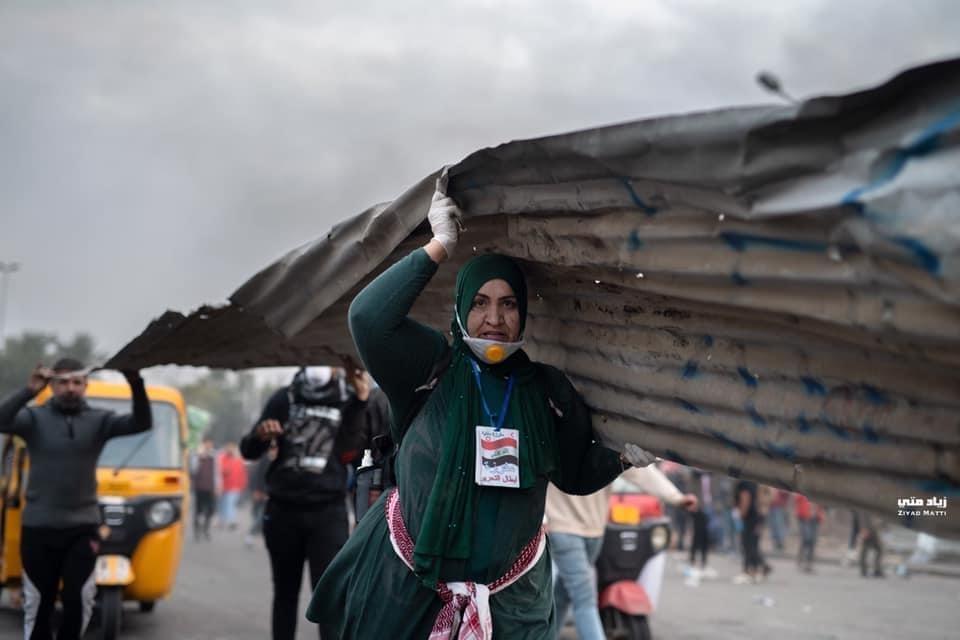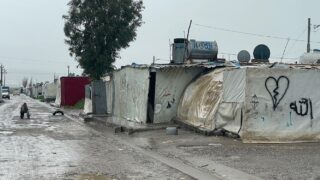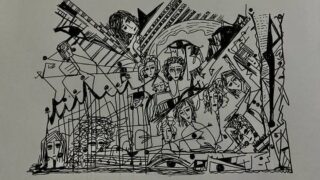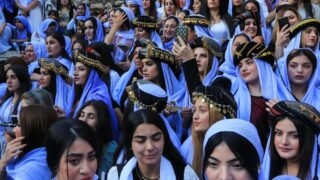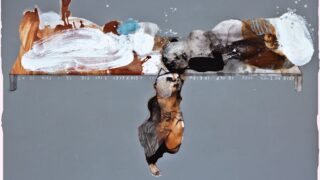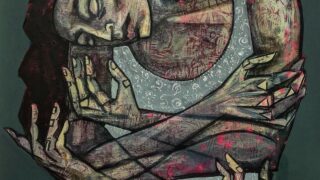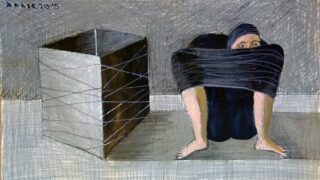
This publication has benefited from the support of the Rosa Luxemburg Foundation. This text may be reproduced in part or in full, provided the source is acknowledged.
Let’s call her Sarah. I met her in 2019 at the Organisation of Women’s Freedom in Iraq in Baghdad. She was running around and playing with two of her friends, her face sparkling with a childish smile. Sarah is 14 years old. She had come to the organisation just a few days before I met her, carrying a new-born child, not yet a year old. Sarah’s father had failed in paying off his debts, and so offered his 11-year-old daughter to his creditor instead, as diyya. The man wedded her as part of a “pleasure marriage” (nikah el-mut’ah) until he got her pregnant, after which he no longer desired her, throwing her out, where she roamed the streets until she reached the organisation. A child carrying a child. Not the first story we hear of, nor will it be the last, with underage girls married off as such in Iraq. While Sarah found her way to an organisation that would embrace her and her new-born daughter, many do not fare as well and meet a much more tragic end. According to statistics collected by the Ministry of Planning in Iraq in 2013, a third of married females in Iraq are minors. Otherwise, were we to scan the events that took place after 2013, such percentage could only grow.
Women’s fate is often interlinked with wars; they pay its highest prices; face all forms of social, political, and economic violence; and their stories, when later told, are most marginalised. To understand women’s presence from all walks of life –from various age groups, social conditions, and regions– in Tahrir’s squares during the October Uprising, we would have to examine the injustice they faced all throughout the years preceding the great explosion.
The Dictator’s Wars
Saddam Hussein dragged Iraq into an eight-year war with Iran (1980-1988), resulting in more than a million deaths on both sides, leaving many widows, orphans, and bereaved parents behind. The weight of Iraq’s economy, consumed by the war, fell onto women’s shoulders, who made up the bigger part of the country’s workforce as men headed to war fronts. Iraqi women sustained economic production in all sectors, including education, healthcare, agriculture, industry, and more. Furthermore, women became the sole providers within their Iraqi households, of children and older parents alike.
Later, Saddam decided once more to solve his disputes through violence and machismo. Once when he punished his opponents by exterminating entire villages in Kurdistan with chemical attacks; and another when he ventured into Kuwait in 1990, occupying it for refusing to exempt Iraq of its debts, which were loans taken out to finance his own war with Iran. He then led Iraq into a third war against the US-led Coalition Forces (the Multi-National Force), called Operation Desert Shield (August 1990-February 1991). It resulted in the destruction of Iraqi infrastructure and an economic siege that lasted until 2013, exhausting the country both economically and socially.
One of the excuses Saddam promoted for the occupation of Kuwait was that a Kuwaiti official had offended “al-Majidaat al-Iraqiyat” [a term Saddam used to refer to Iraqi noblewomen], to the point that the term “Majida” [noblewoman] would feed into sarcasm and ridicule of Iraqi women, both inside and outside Iraq. In the meantime, his eldest son, Uday, would chase after beautiful women in the streets, clubs, schools, and universities of Baghdad, leveraging his power and infamous thuggery to force some of them into having sex with him, which could be described as repeated rape at the very least, and which carried on for a very long time.
The siege eradicated the entirety of the middle class in Iraq. Those who could, immigrated, and those who couldn’t, due to poverty and deprivation, remained. Iraqi women, all of them, were most hurt by the siege. Instead of being celebrating women as saviours of the country’s economy throughout the protracted war with Iran, the regime premised the siege to cancel most of the socio-economic empowerment programmes, childcare facilities previously provided to female employees, literacy and advocacy programmes, and social security. As such, women were driven into unemployment and straight back into their traditional domestic roles. According to UN reports, the percentage of working Iraqi women thus dropped from 23 percent prior to 1991 (highest percentage in the region) to 10 percent in 2000. Poverty squeezed some of them into sex work, and traffickers exported women and underage girls, selling them in Arab and non-Arab countries.
Saddam Hussein realised that religion would be his salvation from the wrath of people, enraged by such harsh economic aftermaths. He therefore changed his Ba’athist secular path in 1993 and launched his religious campaign, to pander to Islamists and win them over. He began by closing down liquor stores, night clubs, and bars in a largescale campaign carried out by Fedayee Saddam [Saddam’s fedayees], known for their violence, committing crimes and carrying out summary executions against sex workers in Baghdad. The latter were sometimes brutally beheaded right in front of their homes and in broad daylight. Likewise, an official resolution was enforced, preventing women under 45 from leaving the country without a mahram [a designated male escort from her family], which encouraged the emergence of fake-marriage brokers, whereby a man would marry a woman on paper, cross her over into Jordan –the only borders open to Iraqis back then– in exchange for a certain amount of money. Looking the other way when it came to honour killings also increased (not that the original Iraqi penal code no. 188 (1969) had been fair to the victims); as such, the Revolutionary Command Council made a decision that reduced sentences given to relatives, not just immediate family perpetrators, broadening the crime scope.
The siege (13 years) eradicated the entirety of the middle class in Iraq. Those who could, immigrated, and those who couldn’t, due to poverty and deprivation, remained. Iraqi women, all of them, were most hurt by the siege.
In the meantime, state-owned media, and state-sponsored arts began to diffuse distorted portrayals of Iraqi women: women were either helpless or disreputable. The media and theatre –which Iraq pioneered– were flooded with debased plays, where women played socially and humanly degrading roles. At the same time, many families resorted to religion to alleviate poverty and deprivation, whereby hijab-wearing and ‘abaya-wearing prevailed among women, not out of religiosity, but rather because of poverty – as many them could no longer afford shopping for new clothes or visiting hairstyling salons.
Enforcing the Tribal Law and Dispute Resolution
Saddam Hussein almost lost control over the central and southern cities of Iraq following the popular uprising against him in 1991, which the regime brutally suppressed, with over 180 thousand killed, most of whom were civilians, summarily executed and buried in mass graves. Saddam could only pander to clans, then, to ensure their loyalty to him. He gave them free rein on civil law, which had previously –upon passing the 1959 Iraq Law of Personal Status, considered ground-breaking at the time– undermined their authority and influence to a large extent.
Disputes and criminal cases would thus be solved beyond city court walls. Furthermore, with the aggravated economic crisis, kidnappings, killings, and theft multiplied and were rendered profitable income for the clan chiefs and their entourage. For example, a diyya would have to be paid to the family of the murdered, defined by the clan, without recourse to the law; likewise, kidnappings are paid off with a diyya, as is theft. Even car accidents could be compensated with a diyya. Sometimes, the diyya for killing is not paid off with money, but with a woman or a girl, or more so, offered as a gift to the family of the murdered person, chosen by the tribe chiefs without referring to the girl’s/girls’ family. Such ancient tribal tradition is called “dispute resolution”. It is justified by tribal men who state that it intermixes kinship with blood, cancelling vengeance as such. However, women are frequently tortured and violated in all shapes and forms for being a “revenge diyya”, paying with her life for a crime committed by her clansman. Moreover, while the obligation to marry before a civil court had been enforced since 1959, marriages would now be held within clan “guesthouses” for girls under 15, without their consent.
According to statistics collected by the Ministry of Planning in Iraq in 2013, a third of married females in Iraq are minors. Otherwise, were we to scan the events that took place after 2013, such percentage could only grow.
Likewise, a tribal custom, nahwa, was reinstalled, by which any clan could reject marriage proposals from men who belonged to another clan, forcing the girl to marry from her own, without her parents’ consent or hers. The Iraq 1959 Law implicitly criminalised those two customs by stipulating that the girl’s consent must be given –requiring a civil contract signed in court – and by criminalising coerced marriages.
US Occupation, Armed Chaos, and Sectarian Fighting
After close to 13 years of economic siege, which led to a collapse in healthcare, economic, and social structures in Iraq, US occupation landed in 2003, following a US and UK-backed allegation stating that Iraq possessed internationally-sanctioned weapons of mass destruction. Following in the footsteps of Saddam prior to his occupation of Kuwait, one of Bush Junior’s pretexts for waging a war on Iraq was the “liberation of Iraqi women”! The exact opposite ensued, though. The US occupation of Iraq terminated whatever infrastructure had survived in Iraq and wreaked havoc on the country, whose price Iraqi women continued to pay. State institutions collapsed in total, the army was dissolved, which created a job market for armed Islamist factions. Following the formation of the first Iraqi government in 2005, under the sectarian power-sharing system imposed by the United States, armed factions began fighting each other, summarily executing and displacing unarmed civilians based on their sectarian identity. Those factions, among which was al-Qa’eda, would recruit fighters from all over the world by using social media and information networks to agitate Muslims around the world against ideas such as the “violation and rape of Muslim women in Iraq carried out by the US army”, which people widely circulated. Ironically, and amidst all such chaos and fighting, Iraqi women were violated by everyone: the occupation army, fighting Islamist factions, and sex traffickers. The militia wars ended in 2008 with the help of Iraqi clans in Sunni areas and the elimination of the al-Qa’eda. Governance in Iraq then turned officially Islamist/tribal. And, despite a constitutionally defined quota of women in the Iraqi parliament, those would only represent Islamic parties, rather than women themselves, along with a futile Civil Alliance therein.
Civil society organisations failed to fill the wide gap chaos and its entrapments created in the shadow of lawlessness, which increased militia oppression and threats against them, particularly against feminist organisations. The battles were many and the needed services plentiful: from attempts to save women and minors from domestic abuse and “honour” killings; to standing in the face of religious parties’ attempts to change the Personal Status law into one governed by religious sects; and attempts to help displaced women on the run from all manner of violence, born out of the different political crises. By the end of 2008, and according to a Brookings report, the number of internally displaced persons in Iraqi camps reached more than 2.8 million. Things were further complicated when the Islamic State (ISIL) occupied Mosul and a number of Iraqi cities in 2014. ISIL committed crimes against those cities and their surrounding villages, the most horrific of which was the one carried out in Camp Speicher in Tikrit. There, more than 1700 unarmed army cadets and personnel were slaughtered by ISIL, followed by crimes committed against the Yazidi minority. Yazidi women were thus taken in as war captives, now sold and bought for sex by ISIS men in slave markets – created specifically for such aims in the Iraqi and Syrian areas fallen under their control. Even when ISIL was defeated and Mosul liberated in 2018, the refugee camps remained crowded with women, Yazidi and non-Yazidi alike, who had lost their villages and homes and, in many cases, their families too. In parallel, the government placed women whose husbands had joined ISIL, or who married ISIL men –many of whom were forced into those marriages to escape ISIL’s brutality– along with their children, in camps near Mosul city, completely closed off and prohibited from leaving.
Years of Protest: Women’s Participation and Mothers’ Unrest
The Speicher massacre revealed the negligence of the military establishment and Iraqi government officials, especially then-Prime Minister Nouri al-Maliki. Affiliated army men were left alone in the military base, without clear orders or information about the unfolding events, which facilitated ISIL’s task of kidnapping and brutally murdering them. Human Rights Watch revealed horrible pictures of the crime, picked up by satellites. Many of the massacred bodies remained missing, despite their parents’ calls for the Iraqi government to reveal information about their children’s fate and to hold the negligent accountable. The victims’ mothers, known as “Speicher Moms” were at the forefront of the parents’ movement, sit-ins, demonstrations, and confrontations with Iraqi officials, which continued until after the parents broke into the Parliament building in September 2014, forcing al-Maliki to renounce his office as prime minister.
The protests continued, which reached their peak in Basra, against poor service and the extended militia control over the city, ongoing since 2014. They were revived in Summer 2018; the numbers were bigger and so was women’s participation; against the continuous power outages and water pollution – which had hundreds of city-dwellers hospitalised. The popular unrest in Basra, in parallel with the consecutive protests, which the Civil Movement had been holding in Baghdad since 2015, was met with popular solidarity all across Iraq, which had still been suffering from booby traps and bombings. Furthermore, sympathy for protests was maintained despite attempts from governmental and militia-owned media to portray the demonstrators as traitors, especially the women amongst them – framing them with accusations often related to “honour” or communication with foreign entities and embassies. And, as per usual, a series of assassinations of activists and movement supporters would begin. This time, however, women activists were included in the assassination spree. Human rights advocate and president of Al-Wid Al-Alami for Human Rights, Suad al-Ali, was assassinated in Basra on the 25th of September 2018. Successive assassinations then took place, one shortly after the other. High-profile women such as that model known for being outspoken, Tara Fares, the plastic surgeon known for treating war victims for free, Rafif al-Yassiri, preceded by Rasha al-Hassan, owner of a beauty centre and a women’s-only coffeeshop in Baghdad.
The victims’ mothers, known as “Speicher Moms” were at the forefront of the parents’ movement, sit-ins, demonstrations, and confrontations with Iraqi officials, which continued until after the parents broke into the Parliament building in September 2014, forcing al-Maliki to renounce his office as prime minister.
Assassinations were written off as anonymously perpetrated, with unofficial stories broadcast through party-affiliated fake accounts, stating that those crimes were committed as part of a “family dispute”. However, the proximity of events and similarity of execution, coinciding with other activist assassinations during the Basra unrest all indicated attempts of powerful people trying to shuffle the cards and lure public opinion away from Basra’s popular movement. As such, they sent a direct message to women: we can and will silence you, free of charge.
Women and the Iraqi Revolution
09-03-2020
People were terrified for a short while, and fear drove many high-profile women to temporarily quit Iraq. However, women returned and, in Summer 2019, were at the forefront of a sit-in organised by a group of highly educated people organised in front of the prime minister’s office in Baghdad, protesting unemployment and lack of job opportunities. The protest continued for more than 50 days, without much official attention, until the end of September 2019, when officials decided to forcefully end it. The pictures and videos of security forces brutalising female protestors and hosing them down with hot water caused popular uproar, added to anger at poor service provision, governmental corruption, and widespread employment, especially among young people. As such, on October 1st, a group of young people took to Tahrir Square in Baghdad to protest, as they would. This time, however, security forces and militias were shooting and teargassing them, with snipers headquartered in an abandoned building in Tahrir Square known by the “Turkish Restaurant Building”. In a matter of two days, snipers in Baghdad, Nasiriya, and other Iraqi governorates killed and wounded around 150 and 4300 unarmed protesters, respectively. That was the flame that set off the October Revolution in most governorates in central and southern Iraq.
“Women are key to revolutions, not imperfections”
With mounting popular discontent, official response pleaded not-guilty of the events, accusing instead anonymous entities of killing and wounding protesters. The United Nations expressed “concern” over the unfolding events in Iraq, as religious authorities in Najaf called for exercising self-control and gave ‘Adel Abdul Mahdi a two-weeks deadline to divulge the names of the murderers. Many voices arose warning people from demonstrating during the Arba’een religious ceremonies, whereas others called for holding those in the squares of protests. Following popular calls on social media, mobilisation began all over Iraq for mass protests to break out on October 25th.
People were terrified for a short while, and fear drove many high-profile women to temporarily quit Iraq. However, women returned and, in Summer 2019, were at the forefront of a sit-in organised by a group of highly educated people organised in front of the prime minister’s office in Baghdad, protesting unemployment and lack of job opportunities.
State officials became increasingly more fearful, and news reverberated of a number of them leaving the country. The government quickly announced on October 24th that it had arrested some of the officers and security service agents responsible for oppressing the protesters, as it insisted on sniper anonymity. Many cities were once more placed under curfew, in an attempt to prevent assemblies in protest grounds. Bridges and some roads were blocked as well to limit protesters’ mobility. And so, people and their families took to the streets, in violation of the lockdown, in what looked like a celebration that lasted until the wee hours of the morning. Protesters then started controlling entry to squares and high buildings – to restrain sniper access, and, in a matter of a few days, squares were quickly rendered family-friendly and child-friendly zones. Likewise, protesters tried to guard those entrances, confronting crowd-control forces that kept firing bullets and teargas in headshots, killing many protesters who were struck on their head by a teargas cannister. One of them was young poet, Safaa Al-Saray, who went by “Ibn Thanwa”, a name he had given himself after his mother’s death, Thanwa, who had raised him and his siblings on her own in a poor area in Baghdad, following her husband’s death. Safaa’s story resembled the majority of Iraqi youth stories. Even though Iraqi society, like the rest of Arab societies, is a masculine society, it is not completely patriarchal. Mothers in Iraq enjoy special status, which strengthened with the loss of fathers in wars and the numerous violent events the country lived in the past 40 years. While men were killing and getting killed, women were raising children. As such, mothers became symbols of defying injustice in Iraqi collective consciousness. And so, Thanwa and her son, Safaa, became icons of the revolution.
Casualties increased among demonstrators, and, subsequently, so did popular momentum on the ground. Women’s presence was quite strong and remarkable, not only in Baghdad, but also in Nasiriya and Basra, even in socially and religiously conservative cities like Najaf and Karbalaa. They came from a variety of ages, cultural backgrounds, and classes, and some of them came along with their demonstrating children. In the squares, they would cook meals, wash clothes, and, quite frequently, form groups delegated to the barriers that separated protesters from “crowd-control”, and calm down some of the more impulsive young men. There were women who volunteered as medical staff and in field hospitals. They joined the frontlines, ready to treat and save the wounded, which ended up killing and wounding many of them too. Similarly, many female students and high-schoolers participated in large numbers in the protests and student sit-ins. Others joined worker unions in their strikes and sit-ins and otherwise, and civil rights activists and journalists produced some of the first publications that covered the protests, like the Tuk Tuk newspaper and Mussawa newspaper.
Despite religious, state-controlled, and party-controlled media attempts to use the usual array of sexist words against protesting women, the latter soon became symbols of the protests. And so, most artworks, whether of poetry, songs, graffiti, and other artforms, raised women up high and sang their praises for the role they played in the revolution.
Female momentum in the protests caught everyone unawares, including male protesters, who realised that female presence not only meant bigger numbers and more pressure, but also wider protection in a country whose people are so used to being killed. It posed an astounding challenge to religious thought that had governed Iraq ever since its occupation in 2003, which treated males and females differently and prohibited their intermixing, especially in lower socio-economic and less educated classes. Their presence in the streets therefore also shattered classist discrimination, which had debased the poor classes and created a halo around the luckier classes. Despite religious, state-controlled, and party-controlled media attempts to use the usual array of sexist words against protesting women, the latter soon became symbols of the protests. And so, most artworks, whether of poetry, songs, graffiti, and other artforms, raised women up high and sang their praises for the role they played in the revolution.
All attempts by the government and its supporters to put an end to such participation failed. Militias and parties targeted women activists in numerous ways, whereby one of the first assassinations of the protests killed activist Sara Taleb and her husband Hussein ‘Adel in Basra. Siba al-Mahdawi was one of the first kidnapped in the demonstrations, activist Anwaar Jassem, nicknamed “Umm Abbas” in Nasiriya was assassinated, whereas Nahawind Turki, known in Nasiriya for her enthusiastic chants and activism, survived a failed assassination attempt.
Similarly, attempts to beat and verbally tyrannise female students out of participating in protests resulted in the complete opposite. Female students challenging school and security authorities would thus become a model to emulate, in a generation completely reliant on the internet in sharing news and pictures, and creating content away from official state rhetoric. The demonstrators affiliated themselves with a culture different than that of their rulers. They were peaceful, openminded, and tolerant of religious, confessional, sexual, and class differences, among others. On the other hand, those politically and economically controlling the country were a bunch of corrupt, closeminded, religious and sectarian fanatics, advocates of violence as a solution to any problem they faced. Even Sadrist Movement leader, Muqtada al-Sadr, self-defined civilians’ ally –particularly after his alliance with the Iraqi Communist Party in 2018 in the Saairoun Alliance (Alliance Towards Reforms)– failed this time in luring civilian activists to his side, especially the women among them, at a time he wished to appear as patron of the revolution. As such, his discourse turned against the revolution. And so Sadrist followers retreated from the squares and began instigating confrontations that would kill and injure many protesters, particularly in Baghdad, Nasiriya, and Najaf. Muqtada al-Sadr denied all such involvement, but stated once more that those events were a mere “ear boxings” for rebellion against his way of managing things. His statement came as response to a mother’s accusation of Sadrists following his orders in carrying out an armed attack in the sit-in square in Najaf, killing her son. Mrs. Shahlaa/Umm Muhannad was in turn hailed another revolutionary icon, fearing no threats, one of which arrived in the shape of a filmed message from “Sadrist Women”, threatening to kill her. She never stopped heading to the sit-in squares, though, leading demonstrations, appearing in the media, and demanding that her son’s murderers, and those of others’, stabbed in the back, be punished.
The conflict between Muqtada al-Sadr and the protesters continued. Whenever he tweeted any threats at them, they answered in chants against him. Al-Sadr would then respond by sending those he called the “Blue Caps” to attack protesters or kidnap anyone who critiqued or chanted against him. Such is what happened to Najafi activist Rana Abdelhalim Assmide’ie, who shared biting critique against Muqtada al-Sadr and his followers in videos widely shared on social media. Because of her criticism, Assmide’ie received many Sadrist filmed threats, particularly for being a woman and from Najaf -Shia world spiritual capital- and of which Sadr considers himself a representative. Assmide’ie also faced a defamation campaign, kidnapping attempts, beatings, and threats.
Female momentum in the protests caught everyone unawares, including male protesters, who realised that female presence not only meant bigger numbers and more pressure, but also wider protection in a country whose people are so used to being killed.
Finally, al-Sadr lost part of his popular base, particularly the young men among them. He considered the revolution to have been derailed from its right track and pronounced a “Reform Revolution Charter”, listing 18 points that held implicit accusations and threats against protesters, as usual. However, it was his point against mixing between the sexes during the protests that invoked ridicule. It led to a widespread Twitter campaign of sarcasm. Still, it was the squares that broadcast the largest response, as mass women’s marches and demonstrations took off in Baghdad, Nasiriya, Basra, Najaf, and Karbalaa, denouncing and ridiculing al-Sadr’s proclamations, where women would repeat that they were “key to revolutions, not imperfections!”
When next I saw her, Sarah wasn’t playing or jumping around. She was in Tahrir square, echoing enthusiastic chants right before the Women’s Freedom Organisation, perhaps hopeful of her daughter’s better future.
The content of this publication is the sole responsibility of Assafir Al-Arabi and Rosa Luxemburg Foundation cannot accept any liability for it.
Translated from Arabic by Yasmine Haj
Published in Assafir Al-Arabi on 29/10/2020

